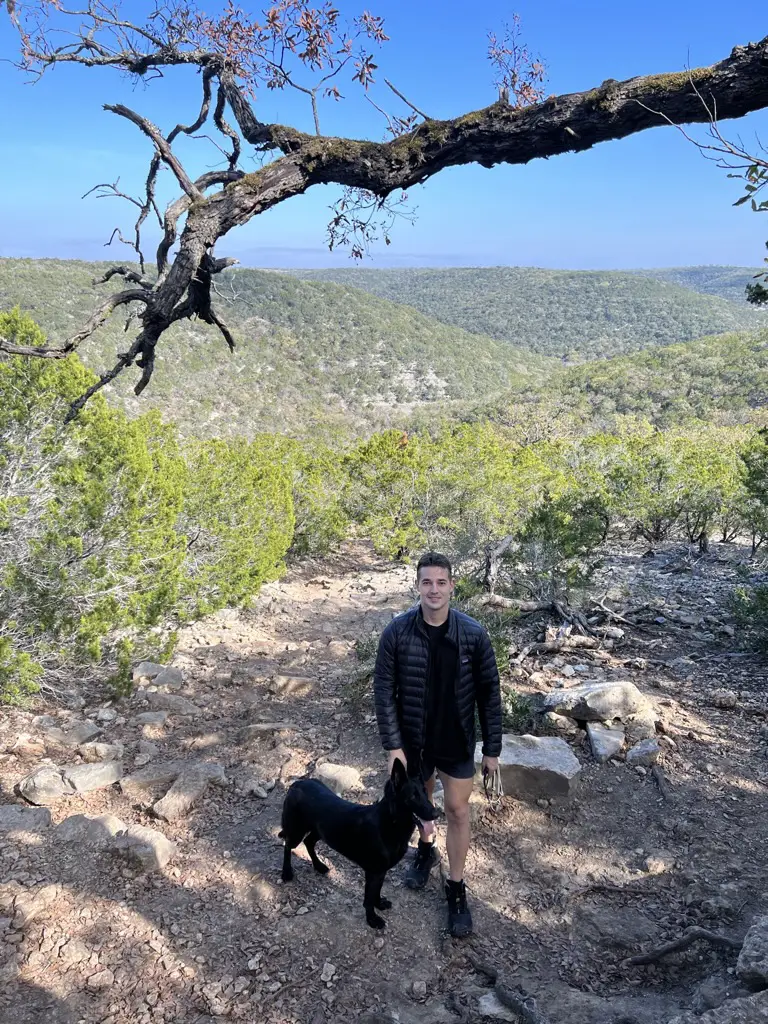We strive to provide you with authoritative, trustworthy, and expert advice. In doing so, the staff at texaswalkabout.com performs extensive research, editing, and fact checking to every post on this webiste. If you feel that this article can improve, please feel free to reach us at staff@texaswalkabout.com
Shrubs provide shade, create a habitat for local pollinators and other wildlife forms, and help stabilize the soil.
But, planting Texas mountain laurel shrubs provides more landscaping benefits. The Dermatophyllum secundiflorum is native to Texas but can also thrive in several regions between USDA zones 7b and 11.
This article will delve into the secrets of growing the Texas mountain laurel, its landscaping significance, and how to care for it so it can continue to grow beautifully in your garden.
What is the Texas Mountain Laurel?
This is a broadleaf evergreen shrub that naturally grows in the arid climate of Texas.
The shrub is native to Mexico and other arid and desert-like regions in Southwestern US, and it’s commonly known as Texas mescalbean, frigolito, hot bean, and coral bean.
In its natural habitat, this shrub can be up to 20 feet tall, but it’s usually shorter when grown in your garden. It’s a slow grower and will probably reach a height of 10 or 15 feet on your land, growing only one or two feet per year.
Historically, this plant was consumed as a ceremonial hallucinogen by some Native Americans. They also used the deep red seeds or beans to make jewelry, although they’re toxic and can even kill a man if swallowed.
Homeowners usually grow this native shrub in their native gardens to support local wildlife. The plants are deer-resistant, so they will protect the rest of your landscape from pests.
Moreover, they can grow in clay soil, where other plants will struggle to get established.
The Beauty of Texas Mountain Laurel Shrubs
These shrubs are evergreen, so they stay attractive throughout the year. The foliage is dark green, and the smooth oval leaves have a leather-like texture.
Texas mountain laurel shrubs are among the earliest bloomers in your garden. They bloom in March and April, and some even bloom in February.
It’s easy to confuse these flowering shrubs with wisteria because the flower panicles look similar. The purple and lavender flowers add a pop of color wherever you grow them, and the seed pods form in the summer.
Some people say that the blooms smell like grape Kool-Aid, so they appeal to local pollinators. However, they’re highly toxic to humans and pets.
Pruning is crucial to keep this shrub under control and maintain its shape. It’s easy to grow, but regular maintenance keeps it in shape.
Why Should You Grow a Texas Mountain Laurel?
The Kool-Aid tree is one of the first choices for growing plants in your Texan garden. Here are some reasons why you should consider growing this evergreen shrub in your garden.
It’s a Native Plant
Growing native plants is one of the best ways to support native wildlife forms. Planting native plants is always a better option than growing invasive ones that can get out of control and might not appeal to the region’s birds, pollinators, and small mammals.
It’s Evergreen
If you want a shrub or small tree that stays attractive all year, the Texas mescalbean shrub won’t disappoint you. It won’t lose its foliage when the temperature drops.
It Tolerates Various Conditions
This plant is low-maintenance once established, so it can be a good choice if you struggle to grow other shrubs and trees in your garden.
It can be an excellent plant for sunny and slightly shady spots and will thrive in clay soil, where other plants won’t grow.
Moreover, it’s drought-tolerant, so it’s suitable for lazy gardeners and those who regularly forget to water their plants. It can be the perfect shrub to add color to an xeriscape yard.
It’s an Early Bloomer
The coral bean shrub will bloom while the rest of your garden is dormant. As a result, local pollinators will have access to the fragrant nectar in the early spring.
Moreover, caterpillars feed on the foliage of this shrub. These caterpillars represent a crucial part of the food chain and provide different forms of wildlife with food.
It Has Several Landscaping Uses
Texas mountain laurel can be a specimen plant in a xeriscape yard. Thanks to its colorful blooms, this can be the focal point among other shorter plants, providing partial shade.
The dense foliage makes this shrub a good hedging and edging plant. You can also grow it as a patio tree, where it requires minimum maintenance once established.
Can You Grow Texas Mountain Laurel From Seed?
Growing Texas mountain laurel from seed is possible, but this can be a lengthy and challenging process. Nevertheless, you can grow a shrub from the seed if you’re patient enough.
Texas mountain laurel seeds are difficult to germinate, so it’s essential to gather the seed pods when they’re still green and collect the seeds when they’re still pale pink.
After that, they become red, and germinating becomes challenging.
Planting Texas Mountain Laurel Step-By-Step
Most people prefer to buy a specimen from a nursery. But if you have some time, you can try growing this shrub from seed by following these steps.
Get the Seeds Ready
Soak the seed pods to open them because they don’t open easily. Then, you should scarify the seeds.
Scarfication is a process that facilitates the germination of the thick seeds of the Texas mountain laurel. Without this process, the seeds might take between five to ten years to germinate.
This process involves using sandpaper or any other tool to remove the thick coating on the seed to allow the oxygen and water to penetrate through and reach the embryo. With access to water, oxygen, and nutrients, the embryo will be encouraged to sprout.
You can start sanding or filing the outer coat until you see a cream-colored tissue. After this process, the seeds will start germinating within two to three weeks.
Plant the Seeds
The seeds can be planted in containers or in your garden, but you should water them daily for two months.
After the first signs of germination, you should water them weekly for a year. This is when the seedlings appear.
Transplant the Seeds
After about one year, the seedlings will be about three to four inches tall, and this will be an excellent time to transplant them to a permanent location in your garden.
How to Care for Texas Mountain Laurel
The Texas mescalbean shrub requires some attention before the roots get established. After that, it becomes easy to care for, although it’s a slow grower.
Here are the right conditions to maintain to keep this shrub healthy.
Light
This shrub thrives in full sun but can tolerate some shade. As a matter of fact, in Texas and other hot climates, it’s best to protect this shrub from the scorching sun.
However, too much shade can make the plant sick, increasing the risk of diseases.
Soil
The Texas mountain laurel thrives in well-draining soil. But it can survive in various soil types, including clay soil, which other plants don’t tolerate.
This plant doesn’t require regular fertilizing. As a matter of fact, too many nutrients in the soil can make the shrub grow too fast, and this can cause the trunk to become deformed.
However, adding calcium to the soil can improve its growth and keep it healthy as it protects the shrub from diseases.
It’s not picky regarding the soil’s pH level but prefers slightly alkaline soil.
Water
Overwatering is a massive problem for the coral bean shrub. This plant requires regular watering only when it’s germinating, and the roots are getting established.
Watering too often can lead to the formation of root rot and might accelerate the growth rate. As a result, the branches will be weak and might break.
Once established, this shrub becomes drought-tolerant.
Temperature and Humidity
As a Texan native, this shrub thrives in hot temperatures. It’s a good choice for arid and desert climates because it can tolerate long periods of drought.
However, it still needs some rainfall to stay healthy. So, if it rarely rains where you live, you’ll have to water it once every two weeks.
You shouldn’t attempt to grow this shrub in a coastal climate or areas with high humidity. Too much humidity can damage the foliage and make the plant susceptible to diseases and pests.
Pruning
Pruning when the plant is still young ensures it will grow with strong branches and healthy foliage. You can also prune this plant to grow as a small tree when it’s young.
Once established, you’ll have to prune it less often.
Too much pruning can harm this plant. So, be careful because, as a slow grower, the branches will take a long time to recover.
Wrap Up
The Texas mountain laurel is an attractive native beauty that adds vibrance wherever it’s grown.
This slow-growing shrub can be an interesting specimen plant or trained to grow as a fragrant hedge.
Growing this shrub from seeds is possible but takes time and patience.
It suits lazy gardeners because it’s low-maintenance once established. It’s also quite tolerant of drought periods.

Robert is a native Texan writer for TexasWalkabout, passionate about Texas culture and food, wearing cowboy boots daily. He interviews local pitmasters and chefs, tastes and reviews innovative dishes, and explores hidden gems and iconic landmarks. Graduating magna cum laude in Cyber Security from the University of Texas at San Antonio, Robert excels academically and professionally while also being knowledgeable in Texas history and culture. After living in Texas for over 28 years, he provides first-hand and trustworthy information for all your Texas needs!
